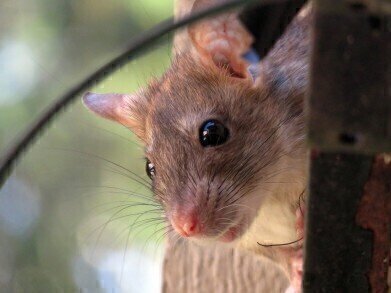News & Views
Giant Rats Used to Sniff out Tuberculosis
May 04 2016
When it comes to disease, rats endure an adverse reputation. Ironically, scientists are now claiming that giant rodents could be the key to detecting and preventing tuberculosis. Aptly named TB Detection Rat Technology, the project has already reported remarkable success, with trained rats currently being used to sniff out the presence of TB in disease ridden East African prisons.
TB now more deadly than HIV
Notorious as the world’s most widespread deadly infectious disease, the WHO recently reported that tuberculosis now trumps HIV’s death count. Despite the fact that it’s easily preventable it continues to afflict a host of East African countries, with Tanzania and Mozambique particularly saddled. A lethal combination of densely populated prisons, poor hygiene, underfunded projects and lack of public awareness has allowed the disease to thrive.
Tackling tuberculosis, rodent style
Now, a Belgian NGO called APOPO has pioneered a new way to manage TB, and rats are at the heart of the movement. Already the company has an armada of 50 African giant pouched rats, all trained as “fully qualified” tuberculosis hunters. It took nine months to train the rats to hone in on the TB scent, a process that was carried out in the company’s headquarters in Morogoro, Tanzania.
After completing their training, the rats are able to power through more than 100 samples in just 20 minutes. They drastically outperform their human lab technician counterparts, who would take over two days to carry out the same task.
Sniffing out disease
So how does it work? The scientists start by collecting phlegm samples, which are then heated in an autoclave to destroy any potential pathogens. A line up of rats is then placed in front of the samples. The presence of TB is indicated when rats hover over a sample for more than three seconds. Amazingly, APOPO maintains that the accuracy rate is close to 100%.
Fast, cheap and remarkably precise, the process marks a new era of efficiency for TB testing. Already the Belgian company estimates that it’s screened over 340,000 samples, and successfully dealt with 39,920 cases as a result.
Rats set to go worldwide
Charlie Richter, APOPO’s U.S. director is confident that its rates will emerge as the technology of tomorrow, stating “We believe our unique TB Detection Rat technology will prove itself as an effective mass-screening tool.”
Plans are already underway to expand the program to a host of high TB-burden countries, with a focus on prisons, shantytowns, factories and other at-risk environments.
“This will improve and save lives all over the globe at a low cost,” he maintains.
Autoclave sterilisation is an essential part of TB Detection Rat Technology, as it prevents both humans and trained rodents from becoming infected. For more insight into how to implement a dry saturated steam steriliser, ‘Planning for an Autoclave Installation’ explores the process in detail, covering what questions to ask, and how to determine desired specifications.
Digital Edition
Lab Asia 31.2 April 2024
April 2024
In This Edition Chromatography Articles - Approaches to troubleshooting an SPE method for the analysis of oligonucleotides (pt i) - High-precision liquid flow processes demand full fluidic c...
View all digital editions
Events
Apr 28 2024 Montreal, Quebec, Canada
May 05 2024 Seville, Spain
InformEx Zone at CPhl North America
May 07 2024 Pennsylvania, PA, USA
May 14 2024 Oklahoma City, OK, USA
May 15 2024 Birmingham, UK


















